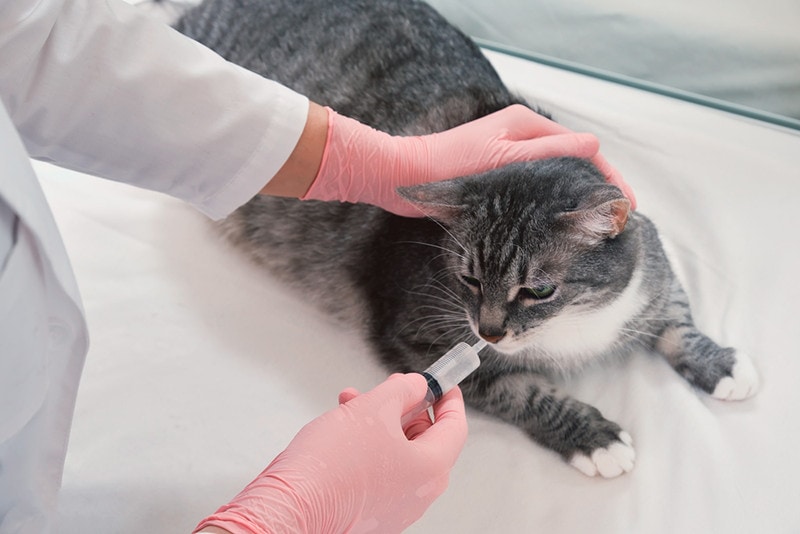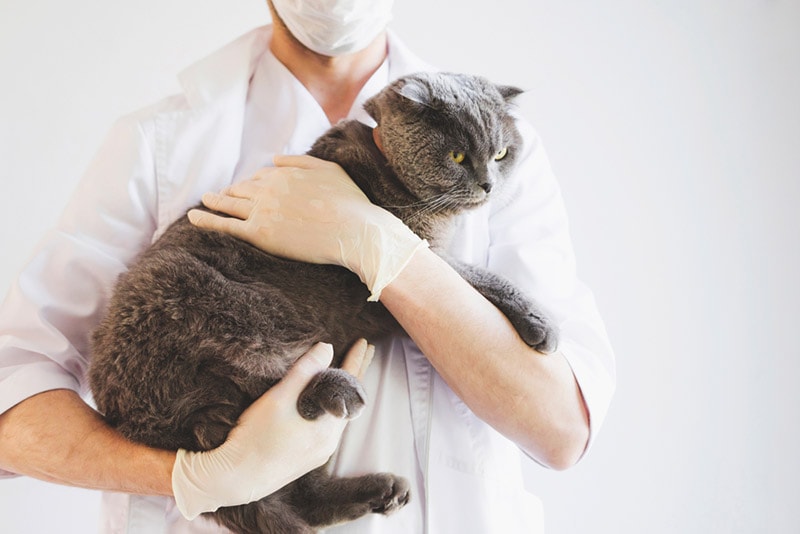Brain Tumors in Cats: Signs, Causes & Treatment (Vet Answer)

Updated on

Click to Skip Ahead
Brain tumors in cats are relatively rare, however, they are a serious type of cancer with potentially devastating effects. If identified promptly, there are some treatment options. They are notoriously difficult to spot as they exist inside the skull, so cannot be seen and require advanced imaging for diagnosis.
Owners can pick up signs and symptoms, so it is important to know what to look out for, as spotting signs early could save your cat’s life.
What Are Brain Tumors?
A tumor is a group of cells that are growing abnormally within body tissue. Technically the term “brain tumor” means a mass in the brain, however, when discussing brain tumors in cats, the term is commonly used to describe any mass located inside the cranial cavity.
Brain tumors may be primary or secondary. Primary tumors originate from cells found in the brain and the membranes of the brain. Secondary tumors are the result of a primary tumor elsewhere in the body that has spread or a tumor that is in some way affecting the brain from nearby tissue such as bone. Brain tumors can be malignant or benign, and no specific breed of cat has been identified as being genetically predisposed. Common tumors seen in cats include:
- Meningioma: Primary tumor which arises from cells that line the surface of the brain
- Ependymoma: Tumor developing from the lining of the ventricle
- Choroid Plexus Tumor: Originating from the choroid plexus
- Glioma: Arising from the brain parenchyma
The most commonly seen brain tumor documented in cats is a meningioma. This tumor stems from the meninges which are a group of cells that line the brain. The tumor grows on the outside of the brain, it grows slowly and forms solitary masses which means it is one of the few tumors that can be treated.

What Are the Signs of Brain Tumors in Cats?
Brain tumors are capable of causing a vast variety of clinical signs depending on where the tumor is located, and which part of the brain is affected. Often the first thing seen is seizure activity, but brain tumors can manifest in many different ways. Signs include:
- Seizures: Physical signs of seizure activity include muscle tremors, head twitching, stiff limbs, collapse or loss of consciousness, hypersalivation, frothing at the mouth, tongue chewing, tonic/clonic movements (jerking of legs, etc.) Your cat may fall over and paddle with their limbs.
- Behavioral changes: Some tumors can affect areas of the brain that are responsible for behavior and emotions. Your cat may show signs of increased aggression suddenly or become withdrawn or depressed. They may seem to forget how to do certain things or not be able to recognize people.
- Circling: They may suddenly start walking around in circles repeatedly with no purpose or aim to their movements.
- Loss of sight: They may suddenly not be able to see out of one or both of their eyes. They may have dilated pupils and their pupils may be of different sizes.
- Changes in appetite and thirst: Your cat may suddenly become ravenous or go off their food completely. They may also start drinking excessively or refusing water.
- Pain in head/neck area: Your cat may hold their neck and head in an extended position or react when touched in these areas.
- Pacing/restlessness: Your cat may start pacing up and down with no purpose or aim.
- Loss of balance: Your cat may be constantly unsteady on their feet or have uncoordinated movements.
- Vomiting: Your cat may start vomiting without any other signs of gastrointestinal upset.
- Disturbed sleep patterns: Your cat may suddenly be awake during the night when they are usually asleep or vice versa.
- Lethargy: Your cat may seem to have no energy and no interest in their surroundings
The clinical signs seen in cats with brain tumors usually result from the space occupied by the tumor and the pressure exerted on the surrounding structures affecting their function. This causes damage to the tissues of the brain and inflammation which can be permanent or reversible depending on the circumstances.
What Are the Causes of Brain Tumors in Cats?
Currently, the risk factors and causes of brain tumors in cats are not well documented. It is thought that there are various factors, including:
- Diet
- Genetics
- Environment
- Chemical or toxin exposure
- Immune function
- Injury/trauma
- Certain viruses
All of these things are thought to influence the development and progression of the tumor.
Interestingly there is some emerging research stating that there is a possibility familial meningiomas in cats have a genetic background. Cats from the same litter could potentially all have this tumor. More studies are required to confirm this.

Diagnosis of Brain Tumors in Cats
If you are worried your cat is showing signs of a brain tumor, arrange an appointment with your vet. Your vet will perform a complete physical exam and take a full clinical history. Blood tests and a urine sample will be taken, although there are no markers in routine blood or urine tests that specifically diagnose a brain tumor. They will, however, give clues as to the functioning state of the body. For example, how well organs are functioning and blood cell counts.
Further imaging can be helpful depending on the type of tumor present. CT or MRI scans can identify space-occupying lesions in the brain (such as a tumor). X-rays and ultrasound imaging can aid in the identification of metastatic disease in other parts of the body such as the lungs or liver.
A biopsy of a suspected tumor is the way to a definitive diagnosis. This needs to be taken under general anesthetic and can be difficult to obtain depending on the location in the brain as some areas are more easily accessible than others.
How Do I Care for a Cat with a Brain Tumor?
Recent advances in veterinary care mean that there is treatment for brain tumors, although it is rare that treatment is completely curative. Treatment objectives usually involve reducing the size of the tumor to enable your cat to have the best quality of life possible for as much time as possible. The treatment and prognosis are dictated by the location and the type of tumor present. The options for treatment include:
Medication
Chemotherapy is not generally used with great success as the brain is protected by something called the blood-brain barrier. This is essentially a gatekeeper to the brain and prevents many things from passing through, including lots of drugs.
Medication can be used to ease or treat clinical signs of brain tumors. If your cat is experiencing seizures, anti-seizure medication will likely be indicated. Anti-inflammatory medication such as corticosteroids can be implemented to attempt to reduce the inflammation and swelling caused by the tumor. Pain medication may be used if deemed necessary. The aim of this treatment is not to cure the brain tumor but to make the cat feel more comfortable and improve their quality of life. It is minimally invasive and relatively cheap compared to other options. If the tumor progresses, it may only be possible to carry out this sort of treatment short term due to welfare issues.
If you decide that you do not want to pursue the options discussed below such as radiation therapy or surgery, medication can be used to provide palliative care for your cat.

Radiation Therapy
Radiation therapy can be used to attempt to eliminate or reduce the size of tumors. Radiation therapy can improve clinical signs quickly. It is usually carried out at a specialist center and is costly. There are side effects from the treatment such as vomiting, ulcers, eye issues, and ear infections. Usually, the benefits of the treatment outweigh the side effects, but this does depend on the individual cat.
While many brain tumors in cats are relatively benign (slow growing and unlikely to spread) and amenable to surgery, some are deep-seated and therefore pose significant surgical risks. Radiation therapy can result in dramatic and rapid improvement of signs. The benefits of this treatment far outweigh the risks for most pets. Radiation therapy normally provides relief from clinical signs for a longer period of time than medication, however, it doesn’t usually cure the tumor, so recurrence of the tumor is common.
Surgery
In some cases, it is possible to completely remove brain tumors—but these cases are, unfortunately, rare. Usually, there are tumor cells left behind that immediately regrow. If surgery is used in combination with radiation therapy this can lead to a longer remission period. Surgery and radiation therapy complement each other too, as after most of the tumor has been surgically excised, the remaining cells are more accessible and easier to attack. In some cases, surgery is carried out first to obtain a tissue sample for histopathology analysis to be able to determine what sort of tumor is present. This gives your vet the ability to predict the progression and eventual outcome of the disease process.
Depending on the location of the tumor, it may be deemed inoperable. This occurs if it is not in an accessible place and removal would involve cutting through healthy brain tissue. On this note, there are huge risks with brain surgery, as damage can occur to healthy brain tissue and the patient can end up worse off than before.
Often a combination of all three treatment options is implemented to give the best results.

 Frequently Asked Questions (FAQs)
Frequently Asked Questions (FAQs)
Are Brain Tumors Painful in Cats?
Pain experienced by your cat does largely depend on the type of tumor present and the location. Some are benign and slow growing, so your cat may show no signs of pain at all until the tumor is very well established. Others are aggressive and spread rapidly. If the tumor is occupying a large space and applying pressure to the surrounding tissues, the pressure alone will cause considerable pain but also this will cause an inflammatory reaction, which will also cause a lot of pain. When a brain tumor is diagnosed, pain relief is usually given.
Can Cats Recover from Brain Tumors?
Most brain tumors in cats can’t be fully cured. Treatment options usually involve treating whatever symptoms your cat is displaying and reducing the size of the tumor. Full removal is not often possible. If surgical excision is attempted, often it is followed up by radiation therapy to try to remove as many of the remaining tumor cells as possible. This will prevent the tumor from regrowing rapidly, although if there are any tumor cells left in situ, recurrence is inevitable.
How Long Can a Cat Live with a Brain Tumor?
The prognosis does depend on the type of tumor present and also the general health status of the cat when the tumor was initially established. One study concluded that cats with an intracranial mass present that were treated with radiation therapy had a median overall survival time of 515 days. Another study including 121 cats being operated on to remove a meningioma reported a mean survival time ranging from 2–4.5 years.
The survival times are very variable depending on the individual situation.

 Conclusion
Conclusion
The diagnosis of a brain tumor is a frightening thing for an owner to hear from their vet. The prognosis for cats with tumors does depend on the type of tumor present, the location and stage at which it is diagnosed, as well as the chosen treatment. Early signs can be non-specific and generalized so it is important to be aware of them and speak to your vet if you have any concerns.
Prompt diagnosis allows for a better prognosis as with most tumors. The main thing to consider when choosing treatment options is the quality of life of your cat. Your vet will be able to guide you.
Featured Image Credit: Alexander Andrews, Unsplash










